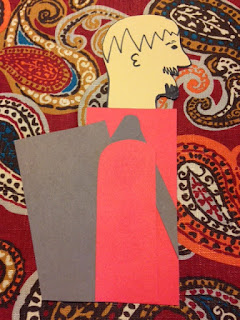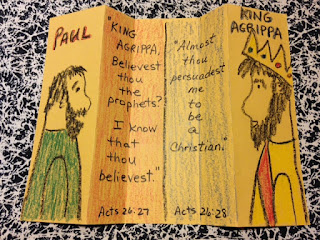VERSES: Romans 1:1-11:30
MEMORY VERSE: Romans 1:16 "For I am not ashamed of the gospel of Christ: for it is the power of God unto salvation, to everyone that believeth; to the Jew first, and also to the Greek."
BOOK TO REMEMBER: Review all 27 book of the New Testament together in class.
PRAYER: Pray that we all stay far away from sin, yet when we stumble, that we will pray to the Lord to forgive us. Pray that we stop doing sinful things and start doing right.
SPECIAL SONG: The Books Of The New Testament (see March 2014 - Songs We Sing In Bible Class #3 on this blog); Be Careful Little Eyes What you See (see March 2014 - Songs We Sing In Bible Class #3 on this blog). All songs can be found on this blog and the tune to each song can be heard by pressing the orange circles.
VISUAL AID: Bible map showing Rome, Large Activity (see Activity below)
LESSON POINTS:
- Paul lived in a time when there were no computers, no email, not even a telephone! Paul had never been to a city called Rome, but, because God wanted to tell the Christians who lived in this faraway city some very important things, God instructed Paul to write a letter to the Christians in the city of Rome. It wasn't just any regular letter; no, this was a special letter that God told Paul to write. This letter was inspired by God or "God-breathed"(Second Timothy 3:16, 17). Paul wrote everything in the letter that God told him to write. It was a very long letter. Paul wrote mostly about sin and how to live a godly life--a life that would please God. The letter was also not written on rectangles of white typing paper like we have now, but on a scroll which was usually like a roll of parchment or a thin, stiff, flat material made from a skin of an animal.
- At the time Paul wrote this letter, the Rome and the Roman Empire was the center of the world. Rome was a very large and important city. It was a wealthy city which meant that the people in the city had a lot of money and they used their money to build important buildings and roads. Not many cities had roads like Rome. There is a saying, "All roads lead to Rome," meaning that no matter where the people lived, they could find their way to Rome by just walking on a road. The road would eventually end up in in the city of Rome.
- Did you know that we can read a copy of this letter that God told Paul to write to the Romans? We know exactly what Paul wrote to the Romans because it is in the Bible! Let's turn to Romans and read the very first word in this long letter. (Read Romans 1:1) The first word is Paul because the Apostle Paul signed his name at the beginning of the letter. Usually, when we write a letter, we sign our name at the end of the letter and put it in the mailbox, but not Paul! Paul wrote his letter, signing it first, then he gave it to a messenger who then took Paul's letter all the way to Rome. Let's look on the map to see where Rome was. We know where the letter was going, but we don't know where Paul was exactly when he wrote the letter because the Bible doesn't say.
- As we read this letter to the Romans, God told Paul to tell the Romans many things like:
- Paul was an Apostle and he was not ashamed of the gospel of Christ because it is the power of God unto salvation. (Romans 1:16)
- The Romans thought they were very wise or smart, but God said they were fools because they had turned away from God to idols and many terrible, sinful things. The Romans should have looked around them and seen all the beautiful things that God had created for them and known that there must have been a Creator (Romans 1:20). He said that the people were so sinful and because they were not sorry for the things they had done, that God had given up on them. (Romans 1:20-32)
- Paul wrote about how to become a Christian. He said that when people were baptized into Christ, they were immersed or buried in water. It is not a sprinkling or pouring of a small amount of water, it is a burial. When the person goes down into the water, their sins are washed away. When they come up out of the water, then they are able to live a new life. The old, sinful man dies and the new man is freed from sin. (Roman 6:1-7). (See Lesson - The Queen's Treasurer - May 2015 on this blog).
- Paul says that nothing should keep us from the love of God (Romans 8:35-39), not death, or life, or angels, or anything! We should always do what God wants us to do!
- Paul tells us in Romans how to get faith: We get faith from hearing God's Word. God doesn't zap us with faith, we cannot buy faith at a store; the only way to get faith is to read the Bible. (Romans 10:17)
- Looking with simple eyes at the book of Romans, we can learn many things. Some say that this book is more difficult than others in the New Testament, but we can always look at the simple things in a book to find out a few important facts.
- The theme of the whole book of Romans is "Justification By Faith." We can be made right in God's sight by having faith in Him. (Romans 5:1).
- For a biblical definition of 'faith', read Hebrews 11:1. To see if we can please God without faith, read Hebrews 11:6.
- Preachers have beautiful feet! Read Romans 10-13-17 to see if this is true.
- We know from the book of Esther (Esther 8:13, 14) that there were posts who rode mules and camels to send letters to the Jews. Jeremiah 51:31 talks about posts and messengers meeting each other. There was a method in place way back then to send letters to people far away.
Materials: 4" x 6" tan construction paper, 3" x 6" red construction paper, 2" x 5" red construction paper, two 1/2" x 4" brown construction paper, 3" x 6" brown construction paper, 3" x 8" white paper, scissors, glue, tape, pencil, crayons, 4" of twine if desired, 9" x 12" blue construction paper if desired (I did not use blue paper or twine).
- Hand out tan construction paper.
- Using most of the paper, draw a long necked messenger's head.
- Cut out head with long neck.
- Glue about 2" of bottom of neck.
- Hand out large red paper. This is the messenger's shirt.
- Attach neck to top of 3" x 4" red shirt.
- Hand out two long strips of brown paper.
- Round corners on one end of each strip.
- Matching rounded corner in the middle of the top of red shirt, angle down and across red shirt. These are the straps of the messenger's mailbag.
- Glue edges of brown strips on red shirt.
- Cut edges of brown strips to make even with red shirt.
- Hand out 3" x 6" brown paper.
- Place 3" x 6" brown paper at an angle on man's back. This is the messenger's mailbag.
- Glue mailbag to red shirt. Cut bottom of mailbag even with red shirt.
- Hand out 2" x 5" red paper. This is the messenger's arm.
- Round top corners of arm.
- Glue arm to the middle of the shirt.
- Write "To ROME, ITALY" on brown mailbag.
- Set messenger aside.
- Hand out white paper. This is the letter to the Romans.
- In the middle of the white paper, write "Letter to the Romans."
- Roll white paper to the middle.
- Secure with tape.
- Roll other side of white paper to the middle.
- Secure with tape.
- If desired, tie twine around the letter, gently.
- Turn messenger on his back.
- Place rolled up letter a little above the the brown mailbag with words not showing.
- Secure with tape.
- Turn messenger over to the front.
- Color.
- If desired, glue messenger to blue paper. (I chose not to use the blue paper.)
- Make certain all students know that this is the messenger who took Paul's letter to the Romans to Rome.
- Take messenger home at the end of class.
















































